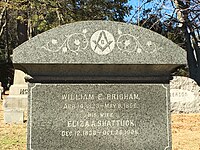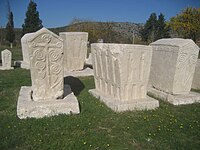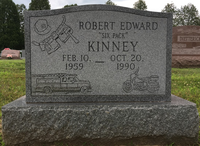Gravestone

Agravestoneortombstoneis a marker, usuallystone,that is placed over agrave.A marker set at the head of the grave may be called aheadstone.An especially old or elaborate stone slab may be called afuneral stele,stela,orslab.The use of such markers is traditional forChinese,Jewish,Christian,andIslamicburials,as well as other traditions. In East Asia, the tomb'sspirit tabletis the focus forancestral venerationand may be removable for greater protection between rituals. Ancient grave markers typically incorporatedfunerary art,especially details in stonerelief.With greater literacy, more markers began to include inscriptions of the deceased's name, date of birth, and date of death, often along with a personal message orprayer.The presence of a frame for photographs of the deceased is also increasingly common.
Use
[edit]Thestele(plural:stelae), as it is called in an archaeological context, is one of the oldest forms offunerary art.Originally, a tombstone was the stone lid of a stonecoffin,or the coffin itself, and a gravestone was thestone slab(orledger stone) that was laid flat over agrave.Now, all three terms ( "stele", "tombstone" or "gravestone" ) are also used for markers set (usually upright) at the head of the grave. Some graves in the 18th century also containedfootstonesto demarcate the foot end of the grave. This sometimes developed into full kerb sets that marked the whole perimeter of the grave. Footstones were rarely annotated with more than the deceased's initials and year of death, and sometimes a memorial mason and plot reference number. Manycemeteriesandchurchyardshave removed those extra stones to ease grass cutting by machine mower. In some UK cemeteries, the principal, and indeed only, marker is placed at the foot of the grave.
Owing to soil movement anddownhill creepon gentle slopes, older headstones and footstones can often be found tilted at an angle. Over time, this movement can result in the stones being sited several metres away from their original location.[citation needed]
Graves and any related memorials are a focus formourningand remembrance. The names of relatives are often added to a gravestone over the years, so that one marker may chronicle the passing of an entire family spread over decades. Since gravestones and a plot in a cemetery or churchyard cost money, they are also a symbol of wealth or prominence in a community. Some gravestones were even commissioned and erected to their own memory by people who were still living, as a testament to their wealth and status. In aChristian context,the very wealthy often erected elaboratememorialswithinchurchesrather than having simply external gravestones.Crematoriafrequently offer similar alternatives to families who do not have a grave to mark, but who want a focus for their mourning and forremembrance.Carved or castcommemorative plaquesinside the crematorium for example may serve this purpose.
Materials
[edit]
Acemeterymay follow national codes of practice or independently prescribe the size and use of certain materials, especially in a conservation area. Some may limit the placing of a wooden memorial to six months after burial, after which a more permanent memorial must be placed. Others may require stones of a certain shape or position to facilitate grass-cutting. Headstones ofgranite,marbleand other kinds ofstoneare usually created, installed, and repaired bymonumental masons.Cemeteries require regular inspection and maintenance, as stones may settle, topple and, on rare occasions, fall and injure people;[1]or graves may simply become overgrown and their markers lost orvandalised.
Restoration is a specialized job for amonumental mason.Even overgrowth removal requires care to avoid damaging the carving. For example, ivy should only be cut at the base roots and left to naturally die off, never pulled off forcefully. Manymaterialshave been used as markers.
Stone
[edit]- Fieldstones.In many cultures markers for graves other than enclosed areas, such as planted with characteristic plants particularly in northern Europe theyew,were naturalfieldstones,someunmarkedand others decorated or incised using a metalawl.Typical motifs for the carving included a symbol and the deceased's name and age.
- Granite.Graniteis a hard stone and requires skill to carve by hand. Modern methods of carving include using computer-controlled rotary bits andsandblastingover a rubber stencil. Leaving the letters, numbers and emblems exposed on the stone, the blaster can create virtually any kind of artwork or epitaph.
- Marbleandlimestone.Bothlimestoneandmarbletake carving well. Marble is a recrystallised form of limestone. The mild acid in rainwater can slowly dissolve marble and limestone over time, which can make inscriptions unreadable.Portland stonewas a type of limestone commonly used in England – after weathering, fossiliferous deposits tend to appear on the surface.Marblebecame popular from the early 19th century, though its extra cost limited its appeal.
- Sandstone.Sandstoneis durable, yet soft enough to carve easily. Some sandstone markers are so well preserved that individual chisel marks are discernible, while others havedelaminatedand crumbled to dust. Delamination occurs when moisture gets between the layers of the sandstone. As it freezes and expands the layers flake off. In the 17th century, sandstone replaced field stones inColonial America.Yorkstonewas a common sandstone material used in England.
- Slate.Slatecan have a pleasing texture but is slightly porous and prone to delamination. Slate was commonly used by colonial New England carvers, especially in Boston where elaborate slate markers were shipped down the Atlantic coast as far south as Charleston and Savanah. It takes lettering well, often highlighted with white paint orgilding.
- Schist.SchistWas a common material for grave making in the American Colonies during the 17th and 18th Century. While harder to Carve than Sandstone or Slate, lettering and symbols usually had to be carved deeper into the stone and therefore held up well over long periods of time. While not as durable as most slate, most have held up well against the elements.
-
TheMaymūnah Stone,a tombstone with an Arabic inscription dated 1174 on a reused Roman marble block. Now exhibited at theGozo Museum of ArchaeologyinMalta.[2]
-
Slate gravestone ofJosiah Leavitt(1679–1717), Hingham Center Cemetery,Hingham,Plymouth County, Massachusetts
-
Slate vestige of a Jewish gravestone depicting atzedakah box.Jewish cemeteryinOtwock(Karczew-Anielin), Poland.
-
Gravestone showing death date of 1639,Wormshill,Kent, England
-
HIS LAST MESSAGE: NO MORE WARS FOR ME– A headstone in theJerusalemBritishWorld War ICemetery onMount Scopus
-
Elaborately carved grave slab atShebbear(Devon, England) showing a skull sprouting flowering shoots, as a symbol of resurrection
-
Schisttombstone dated 1795, carved by Josiah Manning in Mansfield CT
Metal, wood and plants
[edit]


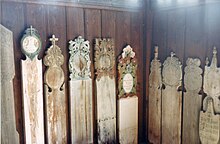
- Iron.Irongrave markers and decorations were popular during theVictorian erain theUnited Kingdomand elsewhere, often being produced by specialistfoundriesor the localblacksmith.Cast ironheadstones have lasted for generations whilewrought ironworkoften only survives in a rusted or eroded state. In easternVärmland,Sweden, iron crosses instead of stones have been popular since the 18th century.
- White bronze.Actually sand castzinc,but called white bronze for marketing purposes. Almost all, if not all, zinc grave markers were made by the Monumental Bronze Company of Bridgeport, CT, between 1874 and 1914. The company set up subsidiaries in Detroit, Philadelphia, New Orleans, and Des Moines; a Chicago subsidiary was named the American Bronze Company, while the St. Thomas White Bronze Monument Company was set up in Ontario, Canada.[3]They are in cemeteries of the period all across the U.S. and Canada. They were sold as more durable than marble, about 1/3 less expensive and progressive.
- Wood.This was a popular material during theGeorgianandVictorian era,and almost certainly before, inGreat Britainand elsewhere. Some could be very ornate, although few survive beyond 50–100 years due to natural decomposition or termites and other wood boring insects. InHungary,thekopjafais a traditional carved wooden grave marker.[4][5]
- Planting.Trees or shrubs, particularly roses, may be planted, especially to mark the location of ashes. This may be accompanied by a small inscribed metal or wooden marker.
Inscriptions
[edit]Markers sometimes bearinscriptions.The information on the headstone generally includes the name of the deceased and their date of birth and death. Such information can be useful togenealogistsandlocal historians.Larger cemeteries may require a discreet reference code as well to help accurately fix the location for maintenance. The cemetery owner, church, or, as in theUK,national guidelines might encourage the use of 'tasteful' and accurate wording in inscriptions. The placement of inscriptions is traditionally placed on the forward-facing side of the memorial but can also be seen in some cases on the reverse and around the edges of the stone itself. Some families request that an inscription be made on the portion of the memorial that will be underground.[6]
In addition, some gravestones also bearepitaphsin praise of the deceased or quotations from religious texts, such as "requiescat in pace".In a few instances the inscription is in the form of a plea, admonishment, testament of faith, claim to fame or even a curse –William Shakespeare's inscription famously declares
Good friend, for Jesus' sake forbear,
To dig the dust enclosèd here.
Blest be the man that spares these stones,
And cursed be he that moves my bones.
Or a warning aboutmortality,such as thisPersianpoetry carved on an ancient tombstone in theTajikicapital ofDushanbe.[7]

I heard that mighty Jamshed the King
Carved on a stone near a spring of water these words:
"Many – like us – sat here by this spring
And left this life in the blink of an eye.
We captured the whole world through our courage and strength,
Yet could take nothing with us to our grave. "
Or a simpler warning of inevitability of death:

Remember me as you pass by,
As you are now, so once was I,
As I am now, so you will be,
Prepare for death and follow me.

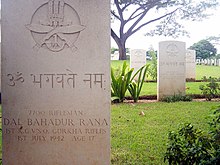


Headstone engravers faced their own "year 2000 problem"when still-living people, as many as 500,000 in the United States alone, pre-purchased headstones with pre-carved death years beginning with 19–.[8]
Bas-reliefcarvings of a religious nature or of a profile of the deceased can be seen on some headstones, especially up to the 19th century. Since the invention of photography, a gravestone might include a framedphotographorcameoof the deceased; photographic images or artwork (showing the loved one, or some other image relevant to their life, interests or achievements) are sometimes nowengravedonto smooth stone surfaces.
Some headstones use lettering made of white metal fixed into the stone, which is easy to read but can be damaged by ivy or frost. Deep carvings on a hard-wearing stone may weather many centuries exposed in graveyards and still remain legible. Those fixed on the inside ofchurches,on thewalls,or on thefloor(often as near thealtaras possible) may last much longer: such memorials were often embellished with amonumental brass.
The choice of language and/or script on gravestones has been studied bysociolinguistsas indicators of language choices and language loyalty. For example, by studying cemeteries used by immigrant communities,[9]some languages were found to be carved "long after the language ceased to be spoken" in the communities.[10]In other cases, a language used in the inscription may indicate a religious affiliation.
Marker inscriptions have also been used for political purposes, such as the grave marker installed in January 2008 atCave Hill CemeteryinLouisville, Kentuckyby Mathew Prescott, an employee ofPETA.The grave marker is located near the grave ofKFCfounderHarland Sandersand bears theacrosticmessage "KFC tortures birds".[11]The group placed its grave marker to promote its contention that KFC is cruel to chickens.
Form and decoration
[edit]This sectionneeds additional citations forverification.(August 2011) |

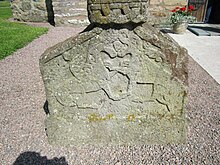

Gravestones may be simple upright slabs with semi-circular, rounded, gabled, pointed-arched, pedimental, square or other shaped tops. During the 18th century, they were often decorated withmemento mori(symbolic reminders ofdeath) such asskullsor winged skulls, winged cherub heads, heavenly crowns, or the picks and shovels of thegravedigger.Somewhat unusual were more elaborateallegorical figures,such as OldFather Time,oremblemsoftradeorstatus,or even some event from the life of the deceased (particularly how they died). Large tomb chests, falsesarcophagias the actual remains were in the earth below, or smaller coped chests were commonly used by thegentryas a means of commemorating a number of members of the same family. In the 19th century, headstone styles became very diverse, ranging from plain to highly decorated, and often using crosses on a base or other shapes differing from the traditional slab. By this time popular designs were shifting from symbols of death like Winged heads and Skulls to Urns and Willow trees. Marble also became overwhelmingly popular as a grave material during the 1800s in the United States. More elaborately carved markers, such ascrossesorangelsalso became popular during this time. Simple curb surrounds, sometimes filled with glass chippings, were popular during the mid-20th century.
Islamic headstones are traditionally more a rectangular upright shaft, often topped with a carved topknot symbolic of aturban;but in Western countries more local styles are often used.
Some form of simple decoration may be employed.[12]Special emblems on tombstones indicate several familiar themes in many faiths. Some examples are:
- Anchor:Steadfast hope
- Angel of grief:Sorrow
- Arch:Rejoined with partner inHeaven
- Birds:Thesoul
- Book:Faith, wisdom
- Cherub:Divinewisdomorjustice
- Column:Noble life
- Brokencolumn:Earlydeath
- Conch shell:Wisdom
- Cross,anchorandBible:Trials, victory and reward
- Crown:Reward and glory
- Dolphin:Salvation, bearer of souls to Heaven
- Dove:Purity,loveandHoly Spirit
- Evergreen:Eternal life
- Garland:Victory over death
- Gourds:Deliverance from grief
- Hands:A relation or partnership (see Reference 3)
- Heart:Devotion
- Horseshoe:Protection againstevil
- Hourglass:Time and its swift flight
- IHS:Stylized version ofiota-eta-sigma,a Greek abbreviation of "Iesus Hominum Salvator"(" Jesus, savior of mankind "); alternatively treated as an initialism for"in Hoc Signo (Vinces)":"In this sign you shall conquer. "Commonly indicatesRoman Catholicfaith, the latter especiallySociety of Jesus.
- Ivy:Faithfulness, memory, and undying friendship
- Lamb:Innocence,young age
- Lamp:Immortality
- Laurel:Victory, fame
- Lily:Purity andresurrection
- Lion:Strength,resurrection
- Mermaid:Dualism ofChrist– fullyGod,fullyman
- Oak:Strength
- Olive branch:Forgiveness, and peace
- Palms:Martyrdom,or victory over death
- Peacock:Eternal life
- Pillow:a deathbed, eternal sleep
- Poppy:Eternal sleep
- Rooster:Awakening, courage and vigilance
- Shell:Birthandresurrection
- Skeleton:Life's brevity
- Snakein a circle:Everlasting life in Heaven
- Square and Compasses:Freemasonry
- Star of David:Judaism
- Swallow:Motherhood
- Brokensword:Life cut short
- Crossed swords:Life lost in battle
- Torch:Eternal life if upturned, death if extinguished
- Tree trunk:The beauty of life
- Triangle:Truth,equalityand thetrinity
- Tzedakahbox (pushke):Righteousness, for it is written "...to do righteousness and justice" (Gen 18:19) and "the doing of righteousness and justice is preferable to the Lord than sacrificial offering" (Proverbs 21:3).
- Shatteredurn:Old age, mourning if draped
- Weeping willow:Mourning,grief
Greek letters might also be used:
Safety
[edit]Over time a headstone may settle or its fixings weaken. After several instances where unstable stones have fallen in dangerous circumstances, some burial authorities "topple test" headstones by firm pressure to check for stability. They may then tape them off or flatten them.
This procedure has proved controversial in the UK, where an authority'sduty of careto protect visitors is complicated because it often does not have any ownership rights over the dangerous marker. Authorities that have knocked over stones during testing or have unilaterally lifted and laid flat any potentially hazardous stones have been criticised, after grieving relatives have discovered that their relative's marker has been moved.[13]Since 2007Consistory Courtand local authority guidance now restricts the force used in a topple test and requires an authority to consult relatives before moving a stone. In addition, before laying a stone flat, it must be recorded for posterity.[14][15]
Gravestone Cleaning
[edit]Gravestone cleaning is a practice that both professionals and volunteers can do to preserve gravestones and increase their life spans. Before cleaning any gravestones, permission must be given to the cleaner by a "descendant, thesexton,cemetery superintendent or the town, in that order. If unsure who to ask, go to your town cemetery keeper and inquire. "[16]A gravestone can be cleaned to remove human vandalism and graffiti, biological growth such as algae orlichen,and other minerals, soiling, or staining.
One of the most important tenets of gravestone cleaning is "do no harm." In the United States, theNational Park Servicehas published a list of guidelines that outline the best practices of gravestone cleaning:
Do
- "Do no harm
- Do select the gentlest cleaning method to accomplish the task
- Do perform small test patches before cleaning the entire stone
- Do follow manufacturers’ recommendations
- Do follow manufacturers’ safety guidance
- Do exercise patience
Don't
- Don’t remove original surfaces
- Don’t use bleach or other salt laden cleaners
- Don’t power wash with high pressures
- Don’t sand blast or use harsh mechanical methods such as power tools
- Don’t use strong acids or bases "[17]
Image gallery
[edit]-
Typical late-20th-century headstone,Dubuque, Iowa
-
19th-century marble headstone,Saints Peter and Paul Catholic Church (Sherrill, Iowa)
-
Grave marker for Horatio Nelson Ball and father, Joseph Ball, Jr., Grandville Cemetery, MI, US
-
Winged skull & winged soul effigies, Morristown, NJ
-
Unconventional tombstone in the Cemetery Park of the "Freireligiöse Gemeinde" inBerlin,Prenzlauer Berg.Tree stump headstones in U.S. cemeteries are often associated with fraternal organizationWoodmen of the World.
-
Der Schlaf(The Sleep), 1907, sculpture byHermann Hosaeusat theI. Städtischer Friedhof Eisackstraße
-
A late-19th-century headstone adorned with theMasonicsquare and compass
-
The grave ofUchida HyakkeninOkayama,Japan.The headstone is columnar, which is a particularly common configuration for headstones in Japan.
-
Tombstone topped with orb symbolizing a celestial body and the reward of resurrection, churchyard ofSt. Peter's Church in the Great Valley,Malvern,Chester County,Pennsylvania
-
Personalized gravestone inscription,Berwick, PA
See also
[edit]- Gravestone rubbing
- Khachkar
- Mausoleum
- Megalith
- Murder stone
- Sarcophagus
- Scottish gravestones
- The Devil's Chair (urban legend)
- Tombstone tourist
- Viewlogy
References
[edit]- ^"Memorial safety".Archived fromthe originalon 11 June 2007.
- ^Bonello, Giovanni(2000)."Histories of Malta, Volume 1"Archived31 October 2022 at theWayback Machine.Fondazzjoni Patrimonju Malti.ISBN978-9993210016.pp. 9–11.
- ^Jarvis, Dale Gilbert; Drover, Kelly (2018)."A Survey of White Bronze Mortuary Monuments in St. Johns's".The Newfoundland Ancestor.34(1): 27–38.Archivedfrom the original on 1 July 2020.Retrieved28 June2020.
- ^Cunningham, John (2004).Hungarian Cinema: From Coffee House to Multiplex.Wallflower Press. p. 213.ISBN978-1-903364-79-6.
- ^Kunt, Ernő (1983).Folk Art in Hungarian Cemeteries.Corvina Kiadó. p. 52.ISBN978-963-13-1359-8.
- ^Fergus Wessell."Headstone Gallery".Archived fromthe originalon 7 July 2013.Retrieved5 September2013.
- ^Robert Fisk: "An urge to smash history into tiny pieces"Archived15 December 2007 at theWayback MachineThe Independent,8 September 2007
- ^Lynch, Michael W. (July 1999)."Grave Problem".Reason.Archivedfrom the original on 11 August 2014.Retrieved7 September2014.
- ^Doris Francis, Georgina Neophytu, Leonie Kellaher. 2005.The Secret Cemetery.Oxford: Berg.
- ^p. 42. Kara VanDam. 2009. Dutch–American language shift: evidence from the grave.LACUS Forum XXXIV33–42.
- ^Bedard, Paul (10 January 2008)."PETA Takes Fight to Col. Sanders's Grave".Usnews.com.Archivedfrom the original on 7 February 2009.Retrieved19 April2012.
- ^Snider, Tui.Understanding cemetery symbols: a field guide for historic graveyards.Castle Azle Press, 2017.
- ^National Federation of Cemetery FriendsArchived25 September 2019 at theWayback MachineSafety in cemeteries guidance
- ^Ecclesiastical Case ReportsArchived12 October 2008 at theWayback MachineRe Keynsham Cemetery Gravestones
- ^"Advice and guidance from The Local Government Ombudsmen"(PDF).Archived fromthe original(PDF)on 7 September 2008.
- ^"Cleaning".Cemetery Conservators for United Standards.Retrieved9 July2024.
- ^"Cleaning Grave Markers (U.S. National Park Service)".www.nps.gov.Retrieved9 July2024.
External links
[edit]- In Search Of Gravestones Old And Curiousby W.T. Vincent, 1896, fromProject Gutenberg
- Azeri.org,Sofi Hamid Cemetery(in Azerbaijani)
- World Burial IndexArchived8 June 2010 at theWayback MachinePhotographs of memorial inscriptions plus free surname search
- A Very Grave MatterOld New England gravestones
- Historic Headstones OnlineProject to transcribe content from historic headstones
- Pennsylvania German tombstonesArchived11 February 2021 at theWayback Machine
- Stockton Universityincludes gravestone imagery in New Jersey
- How to clean a Grave marker by Ralf Heckenbach
- Stone Quarries and Beyond
- "Memorializing the Civil War Dead: Modernity and Corruption under the Grant Administration",by Bruce S. Elliott, inMarkers XXVI,Association for Gravestone Studies, 2011, pp. 15–55. (Reprinted with permission of the"Association for Gravestone Studies".(Details the beginning of the mass production of cemetery stones and the increased use of the sand blast process.)
- Cleaning Grave Markers(a video created by the United States National Park Service on how to clean gravestones and other monuments)

![The Maymūnah Stone, a tombstone with an Arabic inscription dated 1174 on a reused Roman marble block. Now exhibited at the Gozo Museum of Archaeology in Malta.[2]](https://upload.wikimedia.org/wikipedia/commons/thumb/d/db/Maym%C5%ABnah_Stone%2C_Gozo_Museum_of_Archaeology%2C_Victoria%2C_Gozo_001.jpg/144px-Maym%C5%ABnah_Stone%2C_Gozo_Museum_of_Archaeology%2C_Victoria%2C_Gozo_001.jpg)

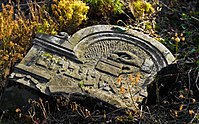

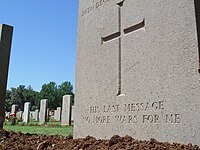
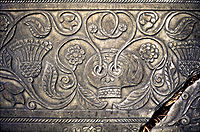





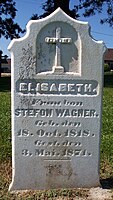
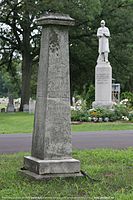


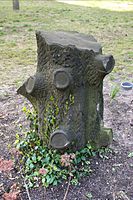
![Der Schlaf (The Sleep), 1907, sculpture by Hermann Hosaeus [de] at the I. Städtischer Friedhof Eisackstraße [de]](https://upload.wikimedia.org/wikipedia/commons/thumb/4/4a/SculptureGraveyardBerlinSchoeneberg1.jpg/200px-SculptureGraveyardBerlinSchoeneberg1.jpg)
